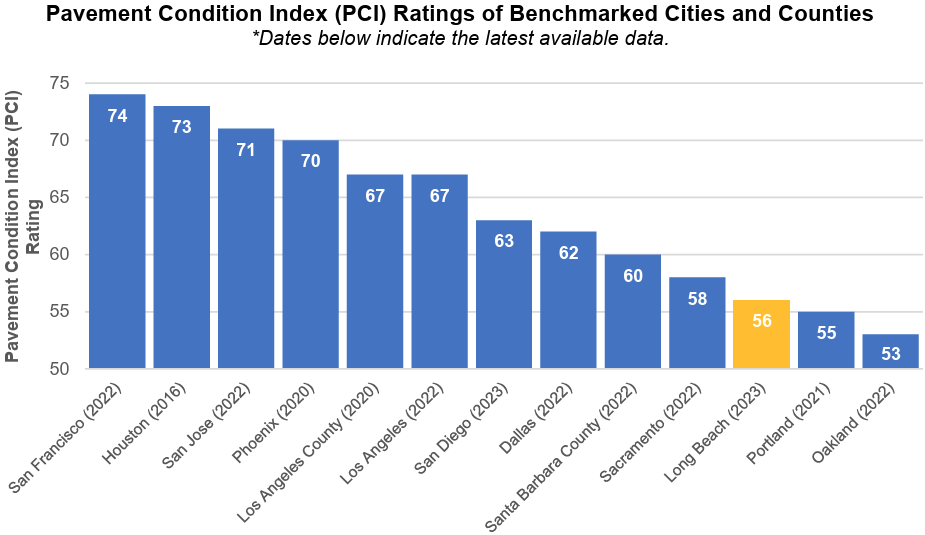Money may not buy happiness, but it can certainly bring better streets if you spend enough of it.
Long Beach streets improved modestly from 2023 to 2025, raising the pavement condition index — a standardized number used to track the health of roads — from 56 to 61 out of 100, according to a city memo released earlier this month.
This translates to improved roadways — especially residential streets — and a 12% drop in the city’s 330-mile backlog of roads in poor or very poor condition that need to be rebuilt.
As of 2025, 15% of Long Beach roads are in peak condition, only needing occasional upkeep. More than a third (38%) are in good to very good condition and best benefit from a sealing treatment. About half of Long Beach streets remain in need of resurfacing, partial or full reconstruction.
In city meetings over the past several weeks, officials lauded the 9% bump as the city’s highest score since at least 2014, when it began using an automated system to track progress.
Outbound Public Works Director Eric Lopez said the score reflected a historic amount of money doled out to street projects, as well as growing efforts by the department to use crack and slurry sealing as a cheap way to maintain good roads.

These numbers are, in large part, the result of about $170 million the city spent between fiscal years 2023 and 2024, as part of its aggressive infrastructure plan to dress up Long Beach before the region welcomes the World Cup in 2026 and Olympics in 2028.
City Manager Tom Modica said this stands in contrast to past governance in the 1990s, citing city data that road-repair budgets between 2023 and 2025 were nearly 1,400% higher than those of 1993 to 1995, when adjusted for inflation. “But clearly more needs to be done,” Modica said.
The memo comes weeks after a city audit found that despite Long Beach spending historic amounts of money trying to fix its deteriorating streets, it failed to prove it spent that money effectively.
Auditors concluded that Long Beach, when compared to a dozen other cities and counties, ranked among the worst for its street conditions while spending far more per mile than most.

Using fiscal year 2025 figures, auditors say Long Beach spent $52,527 per mile of road — the second-most in the study. By comparison, San Diego spent $13,939 per mile, Seal Beach spent $23,352 and the county of Riverside earmarked $17,936.
“It’s a good thing we’re spending all this money, but how cost-efficiently are we being in this?” City Auditor Laura Doud asked.
Reviewing the city’s announcement of its improved pavement index Tuesday, Doud said the results “exceeded her expectations.” In the audit, Doud had said her office anticipated a short-term rise in street quality, reflective of all the money spent in recent years.
Whether Long Beach can continue to improve roads will depend on it budgeting enough money — at least $73.2 million annually.
“But it’s still low,” Doud said of the city grade. More than one-fifth of city streets remain in disrepair, Doud said, and require full reconstruction. This amounts to a $1.2 billion backlog, a lion’s share — $903 million — would need to go towards reconstructing about 200 miles of residential streets.
In its memo, public works officials said if they “remain near” the average $63 million per year, then the city will be able to “maintain a relatively stable network [pavement condition index], though only limited progress will be made in addressing the 20% of streets currently in poor or very poor condition.”
Examining the budget, it’s difficult to say whether the city is setting aside enough. In the proposed fiscal year 2026 budget, the city wants to spend $68.3 million on street repairs, including $9.7 million in curb and gutter improvements. This equates to $17.3 million for arterial corridors, $14.4 million for arterial or major streets, $14.4 million for residential roads and $853,000 for alleys.
By comparison, the city in fiscal year 2023 budgeted $67.4 million from its general fund — including $9.9M for ADA Curb Ramp Improvements — and an additional $25.9 million from the Measure A bond on street repairs. This translates to $13.7 million on arterial corridors, $21.9 on arterial, or major streets, and $29.5 million on residential streets. In fiscal year 2024, the city allocated $75.4 million, which doled out $19 million for arterial corridors, $15.2 million for major streets and $14.4 million for residential streets.
In an ambitious attempt to catch up, outgoing Lopez said his Public Works Department is considering whether to pitch a bond measure, but details remain sparse. A spokesperson said last week the department will propose “multiple funding scenarios” to the City Council sometime in the next fiscal year.
“These scenarios will range from conservative projections, assuming no additional funding for Street Improvements, to models that incorporate varying levels of supplemental investment,” a spokesperson said.
In the newest budget, the city will also ask for three new full-time positions.
Alleys continue to degrade
Gains in street quality weren’t universal in the most recent pavement report. Alleyways fell 18% to an overall rating of 41. Officials attributed the decline to “accelerated degradation caused by recent historic storm seasons” and “long-standing underinvestment.”
Long Beach saw about 24 inches of rain in 2023 and 2024, nearly double its seasonal average. In February 2024, the airport recorded 11.88 inches of rainfall, the third-wettest month on record.
According to the memo, nearly half of the city’s 214 miles of alleyways need to be rebuilt, amounting to a $174 million problem. By comparison, the city set aside a combined $4.2 million for them from fiscal year 2023 to 2025.
“Addressing the backlog in its entirety would require several years, factoring in inflation over that time,” a public works spokesperson said in an email last week.

